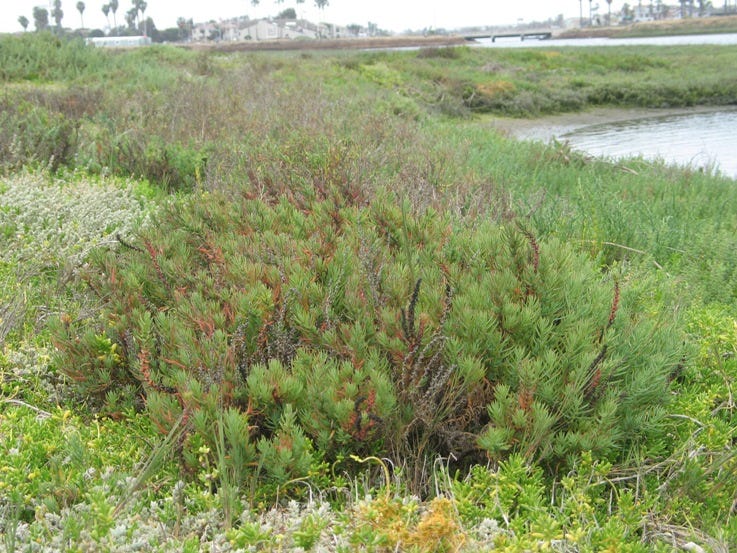In Touch: estuary seablite
It is difficult to think of something as endangered when it's all around you
First of all, I’d like to welcome all the new subscribers to The Green Dispatch, particularly those of you who took advantage of this week’s discount offered to teachers, students, administrators, and anyone else associated with an educational facility. If you’re not signed up and want to get a full subscription for the next year for free, you still have two more days to take advantage of this offer. Simply click the subscribe button and choose the free option. You’ll automatically get a full subscription for a year as though you were a paid subscriber.
If you’re new to The Green Dispatch (or even if you’re a long-time subscriber), please introduce yourself by clicking the comment button.
A few days every week, I drive up to a keypad and punch in a security code. A gate opens, allowing me to enter the wildlife refuge that surrounds the small zoo where I work as a horticulturist. Past the gate, the road narrows to a single lane over a short causeway that connects the tiny island where I work to the mainland.
Driving across the causeway gives me a touch of bliss at the beginning and end of my workday. To the right and left are expanses of an estuary. I almost always see egrets. Sometimes hundreds of godwits or curlews will visit the estuary, each plodding along searching the wet ground for their next meal. The estuary can be a quiet and welcoming respite from the urban sprawl, factories, and freeways that define the rest of my commute.
Most of the marshland in the estuary is perfectly flat, pancake terrain covered with pickleweed and cordgrass, and interspersed with serpentine channels where the flow of the tides initiate. Here and there, a hillock rises, crowned with estuary seablite, with its distinctive light rusty-red branches.
You can also spot estuary seablite because it is a bit taller and a brighter shade of green than the surrounding pickleweed. These differences are subtle. It can be difficult to distinguish marsh plants from one another. They all tend to be green and low-growing, with fleshy leaves. Once you’ve spent any amount of time around southern California marshes, you will learn to identify each species among its neighbors.

Gazing to the north and south while I drive across the causeway, I spy a few seablite, maybe a half dozen in all. Seeing all these plants in close proximity could give the notion that this plant is plentiful. It is not. Estuary seablite grows only in the coastal marshes of northern Baja and southern California. Calflora, the online database of California native plants, records the seablite growing in a handful of locations along the coasts of five counties—San Diego, Orange, Los Angeles, Ventura, and Santa Barbara—a distance of a little over 200 miles. The California Native Plant Society lists the seablite as a 1B.2 plant, meaning it is “rare, threatened, or endangered in California and elsewhere,” and that it is “fairly threatened in California.”
I suspect that estuary seablite was never plentiful, never as common as the cordgrass or pickleweed that can blanket coastal marshes. In years past, it probably grew in a lot more places than it does now. Coastal wetland loss since 1850 is estimated at five million acres, leaving us with about nine percent of the wetlands the Golden State had before white people showed up. What happened to the wetlands? We turned them into marinas and channelized the rivers that fed them. We paved them over for roads, development, and farming. So estuary seablite now has less than one-tenth of the habitat it once had in California. No wonder it is rare and endangered.
At the zoo where I work, I’m involved in a revitalization project for our shorebirds exhibit, a walk-through aviary that recreates a marsh environment. I’ve decided to plant estuary seablite throughout the exhibit, hoping that its greater height will add a bit of dynamic to the greenery. I also hope to include signage describing the seablite and other plants in the exhibit. I know I’m not really contributing to the survival of the seablite as a species with my small planting. My only real hope is that of those who visit our exhibits there might be a few folks who learn of the estuary seablite (as well as the other endangered species we curate at the zoo) and that those folks will help keep our remaining estuaries and other wild places.





You don’t know how that action of adding the seablite to the exhibit will impact others...it is an important step you are taking. 🌍
That 91% wetlands loss has been a tragic loss for migratory birds along the Pacific flyway. It's a shocking reminder of how much harm we have done, one cut at a time.